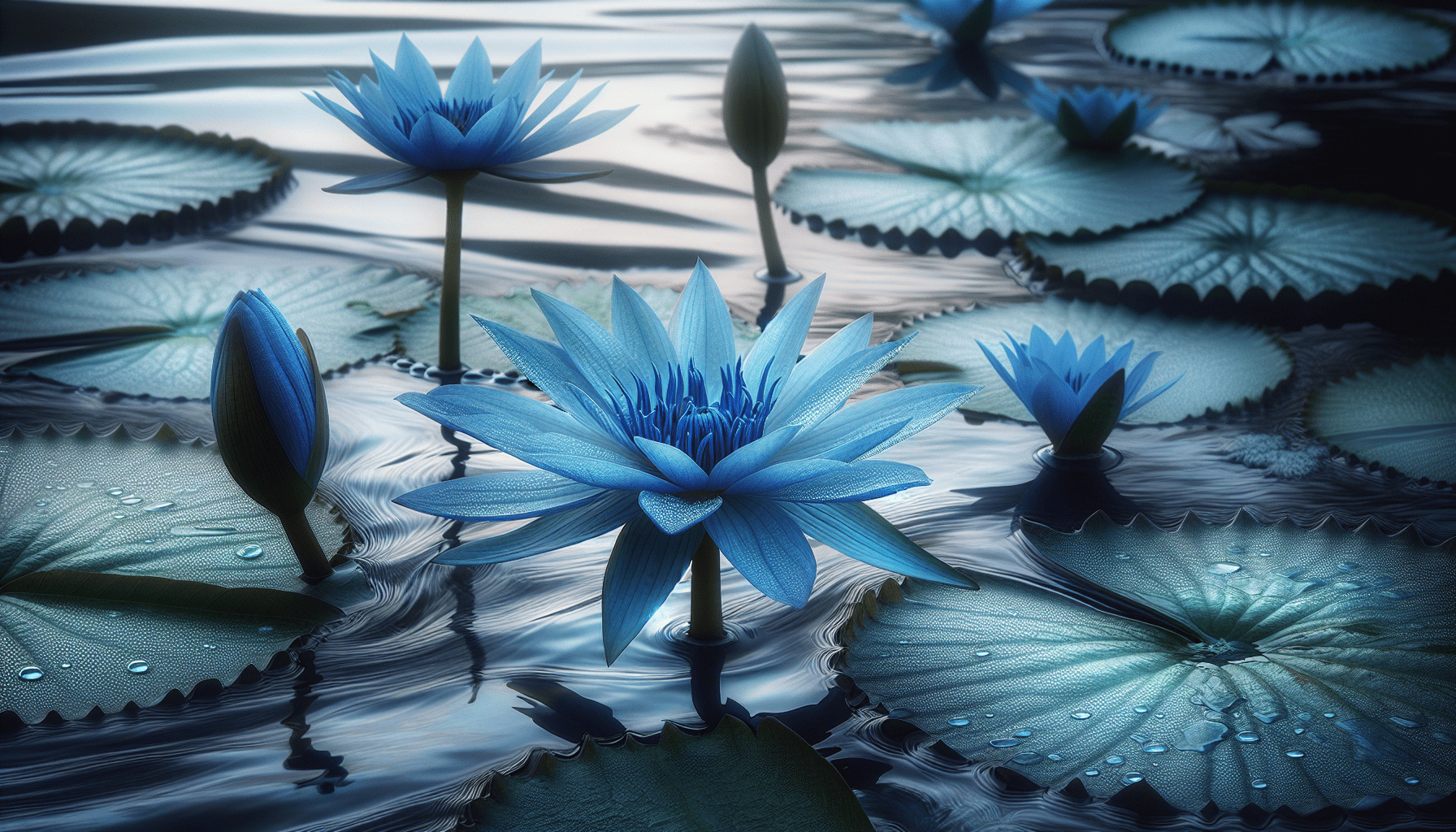In this scholarly discourse, you will gain an understanding of the aquatic weed known as Nymphaea Nouchali. This exploration advances your comprehension of this unique flora, commonly referred to as the “Blue Lotus”, illuminating its characteristics, propagation methods, and the substantial role it plays within its ecosystem. Alongside its scientific attributes, this treatise also addresses its historical significance and various utilizations in medicinal and culinary realms. Taking a journey through this discourse, you, as a reader, are set to expand your knowledge, fostering a deeper appreciation towards this multifaceted aquatic plant, known globally for its striking beauty and diverse applications.

Overview of Nymphaea Nouchali
Nymphaea Nouchali, an enchanting aquatic plant, has enthralled humankind for centuries owing to its aesthetic appeal and medicinal properties. The plant, in all its grandeur, has been aptly nicknamed ‘Blue Water Lily’, ‘Star lotus’, and ‘Water Lily’. Apart from the common nomenclature, its binomial name, Nymphaea stellata, also gets a noteworthy mention in the botanical circles.
Predominantly thriving in the temperate and tropical regions, Nymphaea Nouchali punctuates the landscape of South Asia, East Africa, and Australia. This plant invariably prefers static or slow-moving freshwater bodies, such as lakes, canals, marshes, and reservoirs, where it grows healthily amidst a moderate aquatic climate.
Its taxonomic classification is interesting, as it pertains to the Nymphaeaceae family under the order Nymphaeales. Further on, it belongs to the Plantae kingdom, maintaining its sovereignty in the realm of aquatic plants.
Nymphaea Nouchali Morphology
Taking a closer look at Nymphaea Nouchali’s morphology, one can discern the unique set of floral and vegetative structures that it possesses. To start with the leaf characteristics, Nymphaea Nouchali’s leaves are round and boast a unique radial symmetry. These vivid green leaves are radiant, buoyant, and undergird the anchored plant in its freshwater surroundings.
The plant’s flowers, on another note, are captivating. With their multiplicity of petals and striking hues ranging from white to blue, they exhibit diurnal rhythmicity, signifying that they blossom at dawn and close at dusk.
The plant relies on a robust and continually growing underground stem known as the rhizome for its sustenance. This rhizome is porous, starchy, and fibrous, serving as a veritable storage space for nutrients.
Lastly, the seeds of Nymphaea Nouchali are small, ellipsoid, and are produced in abundance towards the end of the growing season. Resilient by nature, these seeds exude a remarkable ability to survive adverse periods and germinate efficiently post dormancy.
Growth and Behavior of Nymphaea Nouchali
Observe the growth and behavior of Nymphaea Nouchali, and you’ll notice a predictable cycle symbolic of its adaptation to the aquatic habitat. Nymphaea Nouchali has two phases in its growth cycle: the vegetative phase and the reproductive phase.
In the vegetative phase, the plant focuses its energy on leaf and rhizome growth, whereas in the reproductive phase, it invests effort into flower and seed production. This extraordinary transformational process is what makes this aquatic plant truly remarkable.
During the offseason, usually in winter, the plant goes dormant and remains inactive, allowing its seeds and rhizomes to survive harsh conditions. Come spring, these dormant entities spring back to life, initiating another round of growth for Nymphaea Nouchali.

Ecological Importance of Nymphaea Nouchali
Nymphaea Nouchali plays a vital role in ecosystem maintenance, primarily by enhancing biodiversity. This aquatic plant provides a nurturing habitat for numerous aquatic life forms, both flora and fauna.
Numerous insects, fishes, and amphibians find sanctuary in its leaves and flowers, leading to a vibrant aquatic ecology. Furthermore, Nymphaea Nouchali is instrumental in nutrient cycling. It absorbs nutrients from the water and the sediment, and upon decay, returns these substances back into the ecosystem.
Nymphaea Nouchali as an Aquatic Weed
Despite its numerous benefits and aesthetic charm, Nymphaea Nouchali may pose challenges as an invasive species. It can rapidly colonize waters, interfering with hydroelectric power production and canal navigation.
The plant’s robust rhizomes can lead to overgrowth, which may cause disruption in the aquatic ecosystem. However, effective control and management practices such as mechanical harvesting and the use of herbicides can help restrict its unchecked expansion.
Medicinal Properties of Nymphaea Nouchali
Nymphaea Nouchali comes with a treasure trove of medicinal properties that have been harnessed by various cultures for centuries in traditional remedies. Its key compounds, such as flavonoids, phenolic acids, and alkaloids, are associated with therapeutic benefits like anti-inflammatory and antioxidant properties.
Owing to its medicinal potential, current research is exploring innovative applications of Nymphaea Nouchali, primarily in the pharmaceutical industry.
Cultural Significance of Nymphaea Nouchali
The cultural importance of Nymphaea Nouchali is profound. It symbolizes purity and enlightenment in various cultures. It holds a place of reverence in several religious practices and finds a sacred place in Buddhist and Hindu rituals. Its celestial beauty has inspired countless artworks, literature, poems, and music.
Cultivation of Nymphaea Nouchali
Cultivating Nymphaea Nouchali requires specific growing conditions. It thrives best in sunlit freshwater bodies with a mudbase. Regular maintenance, including periodic pruning, prevents overgrowth and keeps algae at bay.
Post-harvest, the plant parts, particularly the rhizomes and seeds, need to be stored in conducive conditions to maintain their viability.
Uses of Nymphaea Nouchali in Different Industries
Nymphaea Nouchali’s application extends beyond aesthetics and ecology. In agriculture, it serves as excellent cattle fodder. The pharmaceutical industry capitalizes on its medicinal compounds for therapeutic formulations. The cosmetics industry uses the plant extracts in various beauty products, owing to their skin-nourishing properties.
Protection and Conservation of Nymphaea Nouchali
While Nymphaea Nouchali is fairly resilient and adaptable, it faces threats from habitat destruction, invasive species, and climate change. Conservation strategies include maintaining its natural habitats, regulating its exploitation, and promoting sustainable cultivation practices.
Legal protection and regulations vary from country to country, depending upon its native or invasive status, further underscoring the global significance of this aquatic marvel.
In conclusion, Nymphaea Nouchali, despite its intimidating scientific name, is a versatile aquatic plant offering ecological, economic, aesthetic, and cultural benefits. Its diverse uses and contributions to various sectors imply its relevance in the present and the future.